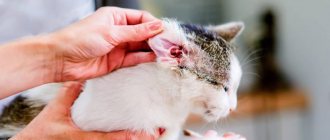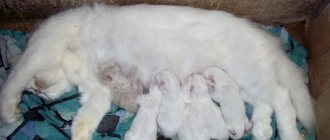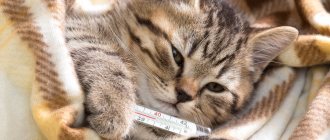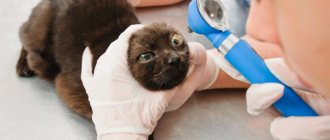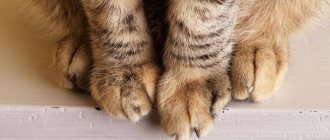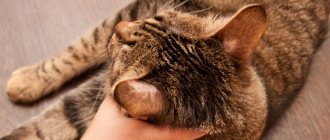What will you learn from the article?
- Causes
- Diagnostics
- Classification of liver diseases
- Major liver diseases in cats Hepatitis in cats
- Lipidosis (fatty hepatosis)
- Cirrhosis of the liver in cats
- Gallstone disease in cats
- Cholecystitis in cats
- Severe liver failure (hepatargia)
- Cholangitis
- Liver amyloidosis
- Liver cancer
The liver is a vital organ, which is called the “factory of the body.” The condition of the animal as a whole depends on its health. Liver diseases in cats account for up to 30% of all non-communicable diseases. Improper feeding, saving on the purchase of quality food, lack of vitamins, minerals and amino acids, poisoning and helminthic infestations - all this causes a blow to the liver. If we exclude all of the above, then the cat’s liver, in most cases, will work perfectly, neutralizing toxins, allergens, and poisonous substances that enter the cat’s body.
In this material we will look at why cats have liver pain and their causes, we will tell you what signs should alert the owner, we will talk about diagnostic methods, methods of treatment and prevention.
Causes
The liver acts as a kind of filter, passing through and neutralizing various foreign and toxic substances.
Therefore, the main reasons for the development of pathologies of this organ are:
- poisoning;
- drug and chemical intoxication;
- a sharp change in the type of food (natural, ready-made food);
- abrupt transfer to a new brand of food;
- overdose of vitamins and minerals;
- feeding low-quality cheap food.
Liver diseases can also be caused by:
- obesity;
- prolonged fasting, anorexia;
- diabetes;
- stress;
- pancreatitis (inflammation of the pancreas);
- malignant neoplasms of internal organs;
- kidney pathologies;
- parasitic infestations;
- elderly age;
- viral and bacterial infections.
Important!
When choosing a pet, keep in mind that some cat breeds have a genetic predisposition to liver disease.
Common symptoms of liver disease in cats
Cat owners should know the main signs indicating possible liver pathologies.
Symptoms of liver pathologies in cats:
- decreased appetite or complete loss of appetite;
- excessive thirst and frequent urination;
- nausea and vomiting;
- bowel dysfunction: constipation and diarrhea;
- sudden weight loss or gain with unchanged diet;
- icteric color of the skin, eyes and mucous membranes;
- change in urine color (from yellow to brown);
- change in the color of feces (from brown to gray or brown);
- intense skin itching;
- protrusion of the liver, its increase in size;
- subcutaneous hemorrhages, skin ulcers;
- swelling of the abdomen due to the accumulation of fluid in the abdominal cavity (ascites), the abdomen takes on a pear shape;
- deterioration of coat condition (dullness), bald patches;
- the skin peels, dandruff appears;
- behavior change: aggression or apathy, depression;
- amyotrophy;
- increased salivation;
- black (tarry) stools;
- multiple bruises on the body due to a blood clotting disorder.
The danger is that the symptoms of liver pathologies are diverse and nonspecific. If one or more of the above signs are present, you should immediately take the animal to a veterinarian. Delay in treatment can lead to serious consequences: hepatic coma, seizures and death.
Important!
In cats with liver pathologies, the body's resistance sharply decreases and they are more susceptible to various diseases.
General therapy
Successful management of patients with fulminant liver failure, sick cats and dogs
requires treatment of the liver disease itself, symptomatic therapy aimed at complications of liver failure, and routine maintenance therapy. Fortunately, hepatocytes have a good ability to regenerate if given adequate support and time. Treatment of the primary disease, if possible, is extremely important. However, a discussion of the therapy recommended for specific liver disease in dogs and cats is beyond the scope of this chapter. Symptomatic therapy for complications of liver failure is similar, despite the internal cause. Maintenance treatment requires maintaining the animal's normal physiological functions while the liver recovers from damage.
Diagnostics
Before making a final diagnosis, the veterinarian must study the history, examine the animal and conduct a series of clinical studies.
Diagnosis of liver pathologies in cats includes:
- general urine analysis;
- abdominal radiography;
- biochemical blood test, determination of the concentration of bile acids, study of the protein component;
- clinical blood test, measurement of bilirubin level;
- Ultrasound of the abdominal cavity and liver.
Additionally, the following may be prescribed: a blood clotting test, a biopsy, a test for bile acids.
Important!
A blood test is carried out strictly after a 10-hour fast.
Hepatitis
There are two types of disease: toxic and infectious.
In the first case, the animal becomes ill after poisoning with toxic substances (poison against mice and rats, as a result of eating spoiled food or taking medications incorrectly).
The infectious type of hepatitis is caused by viruses. In certain cases it may be secondary in nature, caused by complications.
Classification of liver diseases
All liver pathologies are divided into:
- Acute – the disease progresses rapidly (over several hours or days). The pathology is treated subject to timely complex therapy.
- Chronic - the pathology develops slowly over several weeks or months. Complications often occur, and hepatic coma may develop.
Liver diseases in cats are also divided into primary and secondary. In the first case, as the name suggests, the disease is localized in the liver itself, and in the second it is a consequence of problems in another organ.
Hepatosis
The second most severe disease is hepatosis in cats, symptoms and treatment, which is determined strictly after a thorough examination. According to symptoms, there are several main signs:
- When the eyelid is pulled upward, the visible yellowness of the membrane is smoothed;
- What is typical for the skin of the lower lip and gums
The cause of the disease is determined by the ingestion of toxinogenic substances into the body - drugs, poisons, allergens - the accumulation of which in the blood ensures the development of hepatosis.
When a veterinarian makes such a diagnosis, they are prescribed comprehensive treatment. If the cat’s condition is mild, then it is possible to undergo treatment at home, but with strict adherence to all doctor’s instructions.
Major liver diseases in cats
Liver diseases in cats come in a variety of forms, but the most common are:
- Hepatitis (toxic and infectious);
- Lipidosis (fatty hepatosis);
- Cirrhosis;
- Cholelithiasis;
- Cholecystitis;
- Severe liver failure;
- Cholangitis (neutrophilic and lymphocytic);
- Amyloidosis;
- Liver cancer.
Hepatitis in cats
The most common liver pathology in cats (23%). Hepatitis is a liver disease that is accompanied by the breakdown of liver cells, impaired liver function, and impaired metabolic processes throughout the body.
Hepatitis in cats can be:
- toxic;
- infectious.
Toxic hepatitis
The second name of the pathology is acute parenchymal hepatitis of cats.
Causes of toxic hepatitis
- poisoning by poisons and chemicals;
- eating poisonous plants;
- ingestion of rodent poison into the cat’s body;
- overdose of medications and vitamins;
- burns;
- enterocolitis;
- radiation injuries;
- overdose of vitamin A and iron;
- toxicosis of pregnant women;
- feeding moldy feed.
Symptoms of toxic hepatitis
- depressed state of the cat;
- loss of appetite;
- refusal of water;
- hypotension;
- weakening of the pulse;
- yellowness of the mucous membranes;
- weak pulse;
- difficulty and rapid breathing;
- change in urine color (from yellow to dark yellow);
- acute tactile sensitivity;
- increase in liver size;
- hyperthermia.
Treatment
- strict diet;
- administration of glucose, insulin, lipocaine, thiamine, holosas, vikasol, cholenzyme, corn silk infusion;
- daily – mineral water;
- a complete therapeutic diet, adjustment of the daily intake and feeding regimen;
- a course of laxatives to cleanse the intestines;
- a course of antibiotics and sulfonamides to combat pathogenic bacteria;
- in case of complications - prednisolone and cortisone acetate.
Prevention
Prevention of toxic hepatitis:
- control over diet, adherence to diet;
- organization of a balanced, quality menu;
- creation of comfortable living conditions;
- inclusion of necessary vitamin and mineral complexes in the feeding regimen;
- timely detection and treatment of infectious diseases and poisonings.
Infectious hepatitis
Infectious hepatitis in cats is most often secondary in nature and is a complication of the underlying disease. Caused by pathogenic microorganisms that quickly multiply and destroy liver cells.
Causes of infectious hepatitis
- parasitic infestations;
- viral and bacterial infections.
Symptoms
- yellowness of the mucous membranes and conjunctiva of the eyes;
- increased body temperature;
- strong thirst;
- urge to vomit;
- disturbances in the gastrointestinal tract: diarrhea or constipation;
- weight loss.
Treatment
- antiviral therapy;
- antibiotic therapy;
- antispasmodics;
- administration of glucose;
- introduction of vitamins B and C;
- restorative diet - exclusion of dairy, meat products and broths; the diet is based on cereals, decoctions and herbal infusions.
Prevention of infectious hepatitis
- timely vaccination;
- deworming once every three months;
- heat treatment of food or deep freezing of raw foods;
- feeding with high-quality feed with a good shelf life;
- regular ventilation of the home (especially during renovation);
- correct dosages when treating against parasites;
- minimizing contact with stray animals.
Lipidosis (fatty hepatosis)
Fatty liver disease occurs most often and manifests itself in the form of fatty deposits on the liver. This is a very dangerous pathology that threatens the life of the cat. Usually a secondary disease.
Causes
- ulcerative colitis;
- cholecystitis;
- diabetes;
- pancreatitis;
- obesity;
- dysfunction of the pancreas;
- sterilization/castration;
- complication caused by taking medications;
- improper nutrition, overfeeding the animal.
Symptoms
- depression;
- lethargy;
- refusal of food;
- weight loss or excess weight gain;
- loss of muscle mass;
- vomit.
Treatment
- high protein diet;
- limiting animal fats;
- abundant water regime;
- antiemetic therapy;
- forced feeding through a tube;
- antibiotic therapy;
- appetite stimulants;
- blood plasma transfusion;
- administration of vitamin K.
Prevention
- constant monitoring of the cat’s weight;
- when treating obesity, the rate of weight loss should not exceed 1.5% per week.
Important!
With such a disease, the owner should be warned about the likely possibility of force-feeding the cat through a feeding tube, sometimes for six months.
Cirrhosis of the liver in cats
The disease is characterized by the proliferation of connective tissue of the liver, which leads to structural changes in the organ and disruption of its functionality. The pathology is serious and can lead to death.
Causes
- infectious diseases;
- hepatitis;
- prolonged intoxication of the body;
- genetic predisposition;
- violation of bile flow;
- insufficient amounts of proteins and B vitamins;
- cardiovascular pathologies.
Symptoms
- weight loss;
- loss of appetite;
- decrease in general tone;
- jaundice;
- Dyspnea;
- Redness of the conjunctiva;
- an increase in abdominal volume due to the accumulation of fluid in the abdominal cavity;
- diarrhea;
- a well-palpable, enlarged liver.
Treatment
When eliminating the causes of the underlying disease, the following is prescribed:
- parenteral nutrition;
- therapeutic diet;
- adjustment of feeding dosage;
- vitamin therapy;
- choleretic drugs;
- diuretics;
- intravenous administration of proteins (if necessary), glucose, salt solutions;
- glucocorticoids;
- vikasos (for bleeding).
Prevention of cirrhosis
- regular preventive examinations at a veterinary clinic;
- feeding with quality feed.
Video - cirrhosis of the liver in a cat:
Gallstone disease in cats
Gallstone disease is a metabolic disease, the essence of which boils down to the appearance of stones in the gall bladder, in the intrahepatic bile ducts, in the common bile duct. It has been noted that cholelithiasis occurs 3-4 times more often in cats than in cats.
Symptoms
This rare disease is most often asymptomatic. Signs that sometimes appear:
- scratching and itchy skin;
- obstructive jaundice.
Treatment
- thermal procedures;
- a set of measures to relieve spasms;
- choleretic drugs;
- disinfectants;
- ultrasonic crushing/surgical removal of stones.
Prevention
- hygiene measures;
- compliance with the diet.
Cholecystitis in cats
Cholecystitis in cats is an inflammation of the gallbladder mucosa.
Causes
- a cat eating raw river fish infected with parasites;
- feeding cheap dry food of poor quality.
Symptoms
- lethargy;
- jaundice;
- change in stool color (from brown to white);
- change in the quality of feces (to viscous, “greasy” and semi-liquid);
- dry skin.
Treatment
- antimicrobials;
- antiparasitic drugs;
- choleretic drugs;
- therapeutic diet.
Prevention
- heat treatment of fish;
- dosed addition of fish to the diet;
- selection of balanced and high-quality feed;
- timely deworming;
- compliance with the vaccination schedule.
Severe liver failure (hepatargia)
Serious pathology is most often secondary, a complication after illness. It occurs in acute and chronic forms.
Causes
- stress;
- obesity;
- diabetes;
- fatty hepatosis;
- severe poisoning;
- infectious diseases;
- elderly age.
Symptoms
- vomit;
- intestinal disorder;
- lack of appetite;
- decrease/increase in body weight;
- increase in abdominal volume;
- liver odor from the mouth;
- the presence of blood in the stool;
- itching;
- lethargy;
- depression;
- convulsions;
- disorientation;
- state of shock.
Treatment
Hospitalization for this disease is vital. Treatment:
- stopping the root cause of the disease with hormones or antibiotics;
- removal of toxins;
- control of heart activity;
- regulation of mineral metabolism;
- prevention of bleeding in the gastrointestinal tract;
- diet.
Cholangitis
Liver pathology in cats, characterized by severe pain. The animal experiences pain in the liver area and when urinating. With cholangitis, the liver and stomach are affected and hypertension (high blood pressure) is observed. There are two types of the disease: neutrophilic cholangitis and lymphocytic cholangitis.
Neutrophilic (bacterial) cholangitis
This is an acute inflammation in the liver caused by a bacterial infection. Most often caused by the migration of pathogenic bacteria along the bile ducts from the intestines to the liver.
Causes
The disease belongs to pathologies with unknown etiology.
At risk:
- young cats;
- animals with weakened immune systems.
Symptoms
- repeated vomiting;
- high blood pressure;
- icteric skin and mucous membranes;
- decreased appetite;
- lethargy, apathy;
- decreased activity.
Treatment
- antibiotic therapy;
- choleretic drugs.
Prevention
There is no specific prevention.
Lymphocytic cholangitis
The pathology is not associated with infectious processes. Both an independent disease and a complication of neutrophilic cholangitis can develop.
Causes
- elderly age;
- liver fluke infestations;
- weakened immunity.
Symptoms
- enlarged liver;
- enlarged abdomen due to fluid accumulation in the abdominal cavity.
Treatment
- anti-inflammatory drugs;
- immunomodulatory therapy;
- vitamin K injections;
- surgical intervention.
Prevention
There is no specific prevention.
Liver amyloidosis
A rare dangerous pathology characterized by a disorder of protein metabolism in the cat’s body. Amyloid is a type of protein that is deposited in the liver in this disease. This causes disturbances in the functioning of the organ, which can result in liver rupture and internal bleeding. Most often found in Abyssinian and Siamese cats.
Causes
- genetic predisposition;
- vitamin A hypervitaminosis;
- poisoning;
- infectious diseases.
Symptoms
- yellowness of the mucous membranes and skin;
- pale stools;
- Gastrointestinal disorders: constipation, diarrhea;
- apathy, lethargy;
- lack of appetite;
- deterioration of coat condition.
Treatment
The disease cannot be cured. Therapy is aimed at stopping the development of pathology and improving the pet’s quality of life.
- low protein diet;
- injections of compounds to relieve intoxication;
- administration of the drug Colchicine.
Prevention
The disease has no specific prevention.
Liver cancer
Liver cancer is a deadly disease. Various malignant neoplasms can develop in the liver.
Types of malignant liver tumors
- neuroendocrine tumor;
- lymphoma;
- bile duct carcinoma;
- hepatocellular carcinoma;
- mesenchymal sarcoma.
Causes
- bad heredity;
- low immunity;
- hormonal disorders;
- passive smoking (owners smoke in front of cats);
- poor nutrition
- unfavorable environmental conditions;
- stress;
- infectious diseases.
Symptoms
- fast fatiguability;
- sudden weight loss;
- change in color and consistency of stool;
- jaundice;
- loss of appetite.
Treatment
- radiation therapy;
- chemotherapy;
- surgical removal of the tumor;
- immunomodulatory therapy.
Prevention
- ensuring quality food and living conditions;
- increasing immunity;
- regular preventive examinations.
Treatment methods:
- Idiopathic - we act on the cause that led to liver damage (for example, we treat diabetes mellitus, if it were the cause of fatty degeneration)
- Antibacterial. We try to select antibiotics in such a way as to ensure the best effect of the drug reaching the site of inflammation.
- Antitoxic involves the use of solutions and hepatoprotectors.
- Surgical is used to treat gallbladder pathologies, including the accumulation of stones, removal of part of the liver lobes, and acute liver injuries with their rupture.
- Diet therapy, selection of special medicinal feeds - a special, gentle diet will reduce the load on liver cells and enable the cells to regenerate intensively.
Feeding a cat with liver disease
A therapeutic diet is an important component in the treatment regimen for all liver diseases. It’s difficult to create a diet on your own; leave it to the professionals. The veterinarian will select a treatment menu for cats on a natural diet and will recommend a brand of ready-made food for pets receiving commercial food.
Recommended brands of food:
- Hill's Prescription Diet Feline l/d;
- Royal Canin Hepatic HF26;
- Farmina Vet Life Cat Hepatic;
- Monge VetSolution Hepatic;
- Purina Pro Plan Veterinary Diets Hepatic (HP);
- TROVET Cat Hepatic HLD canned.
Read more about what to feed cats with liver diseases.
Preventive actions
Liver disease in cats is easier to prevent than to cure.
Follow these rules to protect your pet from serious illness.
- Choose only high-quality food with a good shelf life. Follow the rules for storing dry food.
- With a natural diet, monitor the balance of proteins, carbohydrates, fats, vitamins and minerals.
- Strictly adhere to the dosage prescribed by your veterinarian when giving your cat medications.
- Do not overfeed your cat with vitamin and mineral complexes; give them strictly as prescribed by the veterinarian.
- Do not allow the animal to come into contact with dangerous toxic substances and poisons.
- Follow your vaccination schedule strictly.
- Treat your pet against parasites once a quarter.
- Minimize stressful situations for your pet.
Prevention
Monitor your pet's diet. Do not feed your dog or cat food from the table. Buy only high-quality, proven food. If your pet is on a natural diet, give raw lean meat, boiled fish, fresh vegetables and fruits. Wipe or steam the greens for better absorption. Avoid sausages, sausages, do not give rotten, bad food.
Other recommendations:
- Remove toxins that may harm the liver. This means that you need to avoid unnecessary pesticides and medications. Avoid frequent cleaning using household chemicals.
- Synthetic vitamins and minerals can be given strictly according to the instructions, without exceeding the course duration and dose.
- Supplement with the antioxidants glutathione, the amino acids N-acetylcysteine (NAC) and S-adenosylmethionine (SAMe). They bind to toxins in the liver before the poisons can damage the gland. Be sure to consider the dosage.
- Get vaccinated against deadly diseases on time.

